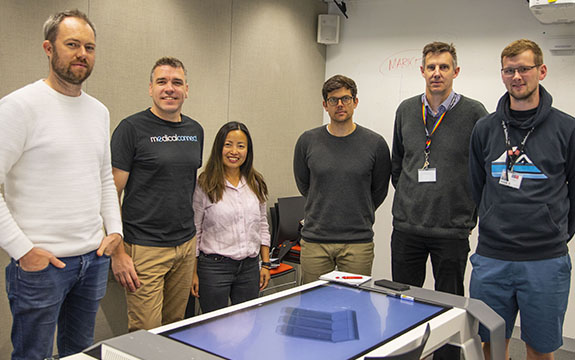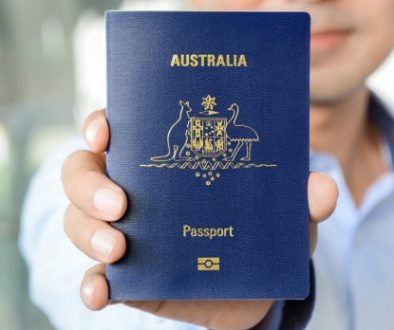Swinburne and Medical Connect Democratise Air Travel
Swinburne’s Centre for Design Innovation has helped design and test a new aircraft seating design that could make transporting patients by air accessible and affordable. This innovation can save lives.
Presently, the only options for patients are air-ambulance, chartering a flight, a commercial stretcher (if available) or wait to get better. All of these options are costly or can have long delays. A luxury most patients don’t have.
As part of a partnership with Medical Connect, an organisation specialising in the transport of patients, Swinburne is exploring how commercial airlines cabins can be reconfigured to accommodate an aviation-approved hybrid stretcher.
Medical Connect co-founders, husband and wife duo Andrew and Linda Heath, believe there is potential to offer low-cost patient repatriation services on domestic and international routes for non-emergency patients within Australia.
“The seating alteration will save patients up to 75 per cent in travel costs for people who need to return to their home country or travel overseas for medical attention,” says Mrs Heath, who completed a double degree in Chemical Engineering and Business at Swinburne in 2004.
Mrs Heath says some of these options may be covered by a person’s private health insurance or a government subsidy, but often the patient is left out of pocket.
“To get somewhere within Australia might cost $20,000 but to get back home from overseas can cost hundreds of thousands. Some people have to mortgage their house just to access treatment away from home or just want to get back to their families.”
The seating alteration is being tested at Tullamarine airport.
“Medical Connect is not about creating a new aeromedical fleet – we’re about the sharing economy by working with commercial airliners we want to replace overly expensive options that are the currently available. We look to revolutionise the way patients travel and eventually be in every airplane in the world.
“Customers with medical or physical needs who are unable to sit up during take-off or landing, have mobility limitations, or need a stretcher should be able to travel comfortably with a more accessible and affordable option,” Mrs Heath says.
Developing a prototype
Medical Connect was established in 2006 and their project was one of a handful chosen for the 2019 Victorian Medical Device Partnering Program (MDPP). MDPP is a Swinburne-based ideas incubator that supports early-stage innovation and technology development. The MDPP offers expertise and project funding to translate medical or assistive device ideas to tangible products.
Participants have access to extensive consultation, validating the technical and commercial viability of their idea, and participate in workshops with experts in relevant sectors, and may then be eligible for project funding.

The Swinburne and Medical Connect team (L to R): Matthew Blythman, Andrew Heath, Linda Heath, Dr Boris Eisenbart, Matt Richardson, Dr Benedikt Lux
Mr Heath says the assistance of MDPP, combined with the input of Swinburne’s expert researchers, provided the best chance to develop and commercialise the project.
“What we liked most about the MDPP opportunity was partnering with Swinburne and researchers from its Centre for Design Innovation who have significant industry experience and technical knowledge.
“They could help us to test assumptions and provide technical knowledge to convert our idea into a physical prototype that we can take to industry and the market.”
Course Director of Swinburne’s Product Design Engineering program, Dr Boris Eisenbart, is driving the development process for Medical Connect.
“At Swinburne, we are very good at working practically. We’re strong in research and have exceptional facilities, and Medical Connect will benefit from this – from what I’d like to call the Swinburne advantage,” Dr Eisenbart says.
“The Centre for Design Innovation digitally rendered the Medical Connect device and we build a full-sized mock-up. This will be used in a real-life environment test at Tullamarine on an actual airplane which will allow us to check how it works and where we need to make changes for how it will fit.
“From here we’re going to adjust where necessary, and by the end of 2019 we will build a composite carbon-fibre prototype that Medical Connect can take to industry and the market.”
Swinburne’s Aviation Postgraduate Course Director Dr Matthew Ebbatson also contributed his knowledge and expertise in aviation regulation to finetune aspects of the project.
About Medical Device Partnering Program
The Victorian MDPP partnership is based at Swinburne and brings together CSIRO, The University of Melbourne, Monash University, RMIT University, Australian National Fabrication Facility (ANFF) and BioMedical Research Victoria.
MDPP Victoria Director and Swinburne Professor of Biomedical Engineering, Sally McArthur, says MDPP is about co-creating solutions for healthcare and need to identify useful and usable ideas early on.
“MDPP is also about bringing together experts and stakeholders in the medical device industry who can help workshop ideas into fully-developed concepts, plan a path towards commercialisation and facilitate ways to achieve medical technology development in Australia,” Professor McArthur says.




